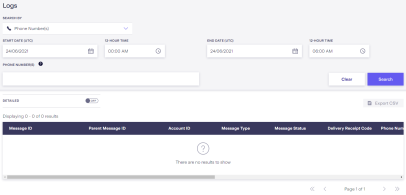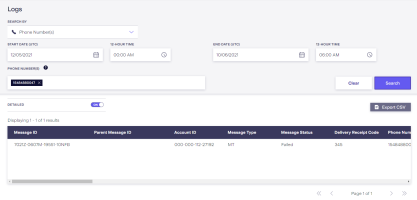Activity Logs
Logs show SMS activity on specific phone numbers. It lets you obtain status and other information about messages that OpenMarket processes for data four months prior to the Message Accepted date. Records are saved for a default period of four months, once it is recorded in the application log. After four months the record is deleted. Customers cannot set their own retention periods. For more information on data retention, see GDPR compliance.
In this topic you will find:
- Accessing Logs — How to access and use the tool to perform an SMS activity search.
- Message activity search results fields — Descriptions of the fields found in the search results.
Accessing Logs
The Logs tool can be accessed from Customer Portal by clicking the Analyze menu and selecting Logs.
Logs main page
On Logs main page you can search for message activity by any of the following:
- Phone Number(s) — The phone number for the end user. This is the default setting when accessing Logs.
- Message ID(s) — The unique ID(s) assigned to the SMS message(s) by OpenMarket.
- Subaccount — Any subaccount associated with the message.
- Note 2 — Any free-text that was added to the Note 2 field of the message.
If you are using RCS, and are provisioned for SMS fallback, you can use Logs to search for SMS message activity. However, the tool does not support searching for RCS message activity. For more information on how SMS fallback works, see Features of RCS.
Note: Subaccount and Note 2 are optional parameters in sent (MT) messages. If your message did not include either of these parameters, no information will be returned. In addition:
• Subaccount is only available when using the UKGW API. It is not used in either of the Global SMS APIs.
• Note 2 is only available when using either the SMPP Global SMS API or the HTTP Global SMS API.
Once all your search parameters are configured, clicking Search will return SMS activity data.
To view SMS activity logs:
-
Select a search option: Phone Number(s), Message ID(s), Subaccount, or Note 2.
The search text box adjusts based on your selection. The search text box also indicates how you should enter your search criteria.
-
Enter the relevant information in the text box based on the Search By selection.
- If you select Phone Number(s) or Message IDs(s), enter one or more phone numbers or one or more message IDs.
- If you select Subaccount enter a single subaccount number. Multiple subaccount numbers are not supported.
-
If you select Note 2, enter the text exactly as it was added in the Note 2 field of the message. Partial text and multiple Note 2 fields are not supported.
Note: Searching by Subaccount and Note 2 can be time-consuming. When selecting these fields to search by, be aware that the process can take several minutes or more to complete. In some cases, the search might time out before finding any results. Time out is set to 30 minutes. To shorten the time it takes to run the search, consider narrowing down the time frame using the Start Date and End Date, or to close the window to cancel an activity report that's taking too long.
An alternative to using SMS activity search for Subaccount and Note 2 would be to create a custom SMS Detailed report in Reports using these fields. See SMS Detailed Reference for the steps.
-
Enter a Start Date and End Date to narrow results. The date and time are based on when you submitted the messages. Dates are formatted using DD/MM/YYYY. The time field uses the 12-hour AM/PM format.
- For Phone Number(s) and Message ID(s), the time frame within which you can search is 30 days from the selected Start Date.
- For Subaccount and Note 2, the time frame within which you can search is two weeks back from the current date, and you can only select a time period of 0-24 hours within a single 24-hour period. The default value is six.
-
Click Search.
The search returns the results in a table, with up to 50 results displayed in the default Simple view, and with a maximum of 500 total results returned. To view more than 500 results, click the Export CSV button to download the results in a format that you can open as a spreadsheet, which returns all records.
If you want to see more fields returned in your default results table, click the DETAILED toggle to activate more results fields.
See Message activity search results fields below for descriptions of the fields.
Note: Click Go to full-page version to open your workspace in a new window with right- and left-pane navigation removed. To return to the default view, click SMS Messaging above the SMS Activity Search title. Switching between views resets your workspace. Make sure that you set your preferred view before performing a search.
Message activity search results fields
The information in the following table describes the fields returned by Logs as part of its message activity search.
Summary view
|
Field |
Setting type |
Description |
|---|---|---|
|
Message ID |
Default |
The identifier OpenMarket assigns to your message. Multipart messages have message IDs for each message part and for the entire message. This means the table has an entry for each part and an entry for the entire message. |
|
Parent Message ID |
Default |
For multipart messages only, this column shows the ID of the entire message. |
|
Account ID |
Default |
The ID of your OpenMarket account. |
|
Message Type |
Default |
Indicates whether the message is an MO (mobile originated) or MT (mobile terminated). |
|
Message Status |
Default |
The current or final delivery status of a message, which can be: Delivered, Awaiting Report, or Failed. |
|
Delivery Receipt Code |
Default |
A number that identifies the current or final delivery state of a message, such as: 0 (message sent), 4 (message delivered), 811 (message delivery error-message expired). |
|
Phone Number |
Default |
The phone number that serves as the source or destination number for the SMS message. |
|
Originator |
Default |
The source number used to send an MT message or receive an MO message. Originators include short codes, text-enabled landlines, toll-free numbers, and long codes. |
|
Operator |
Default |
The OpenMarket ID for the mobile operator associated with the end user's phone number. |
|
Operator Name |
Default |
The name of the mobile operator associated with the end user's phone number. |
|
Content |
Default |
The contents of the SMS message. This will be either text or binary data. |
|
Charge Type |
Default |
A number that indicates the type of messaging interaction. If you are using our HTTP Global SMS API, this can be:
If you are using our legacy SMS v3 API, this can be:
|
| Accepted Date | Default | The time and date (in UTC) when we accepted a valid message request from your account or from a mobile operator. |
| Delivered Date | Detailed | The time and date (in UTC) when the end user received the message. This is based on the delivery receipt we receive from the mobile operator. The accuracy of the receipt depends on the mobile operator and the region that the message was sent to. |
| Updated Date | Detailed | The time and date (in UTC) when the most recent event happened related to this message. This is most often the time when we received the final delivery status from the mobile operator. |
| US Program Id | Detailed | This identifies a pre-provisioned program that's linked to the short code you are using. Used only for the US and with AT&T. |
| Operator Lookup | Detailed | Returns "true" or "false" depending on whether your account has been provisioned to use Mobile Operator Lookup service. |
| Source TON | Detailed | The type of originator (source), e.g. short code, alphanumeric string, or other international-format number. only available when using the UKGW API. |
| Destination TON | Detailed | Details (Type Of Number) about the number to which the end user sent the message. only available when using the UKGW API. |
| DCS | Detailed | Data coding scheme (default value: 0x00). Only available when usingSMS SMPP. |
| User Agent | Detailed | The type of agent through which the message was delivered, e.g. V4HTTP. |
| User Data Header | Detailed | Programmatic data that is sent as part of the message. It specifies how the message should be formatted and processed. For example, it is used to ensure multipart messages are combined on the end user's phone. This field might be useful if you are examining or reconstructing multipart messages sent by an end user. Both MT and MO messages may include a UDH. |
| Purpose | Detailed |
This identifies whether the message was sent as promotional or transactional. Valid for India only. |
| Country Code | Detailed | The two-letter code that identifies the country or region. For example, AU (Australia) or CA (Canada). You can find a list of the codes on Wikipedia. For MTs, this is the country of the destination For MOs, this is the country of the originator |
| Country Name | Detailed | The name of the country in which the end user's phone number is registered. The value unknown means that we were not sent the country details back from the mobile operator (most operators include this and other details in the delivery receipt they send us). It is not linked to the delivery status of the message. You can alternately use the Country Code, which is the two-letter code for a country or region. |
| API Version | Detailed | Determines the API version. This field is left blank for MO messages. This is useful in custom reports only if you are currently using multiple OpenMarket APIs (e.g. both the version 3 or version 4 options), or are transitioning from one API to another (e.g. from the legacy UK APIs to version 4). |
| Campaign ID | Detailed | The unique identifier for a global campaign, which is associated with an account ID and name. |
| Subaccount | Detailed | This field is only populated if you are using the UKGW API. It contains information included in the MT message request. |
| Note 1 | Detailed | Include this field if your MT message requests specified Note 1; otherwise, you can ignore this field. This field is empty for MO messages. Contains information included in an MT message request. This field is intended for per-request data, such as an ID that your system generates. It has no effect on the message or its delivery. |
| Note 2 | Detailed | Include this field if your MT message requests specified Note 2; otherwise, you can ignore this field. This field is empty for MO messages. Contains information included in an MT message request. This field is intended for per-request data, such as an ID that your system generates. It has no effect on the message or its delivery. |

